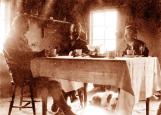2
The history of Millertown is a story of men, horses, oxen and steam in a capital venture that defines the men who worked there. An economic venture into the wilderness of central Newfoundland that changed four hundred years of fishing history for the Newfoundlander's who began working their.4
Arriving in St. John's Newfoundland in August of 1900, Lewis Miller was delayed in St. John's for a month while the branch railway line to Red Indian Lake was being completed. This delay was costly as he had with him a workforce as well as the equipment, horses and oxen for the logging venture.6
Before winter's snow he built the town to house the families of the workforce who had brought with them all their household effects, to live in the Newfoundland wilderness. Living in tents during construction, the construction of accommodations had to be completed, then, winter logging operations could begin. With the railway link finished, construction started on the sawmill, as the equipment could now be brought to the site.8
Winter saw the completion of the mill with the town covered in a blanket of snow, as seen from a hill overlooking the town and lake, where a community church and school were being built.10
During the winter freeze up piers were built to anchor the holding boom required to hold the logs from drifting off by the changing winds.12
By spring the sawmill was completed, ready for the pine logs that were cut during the winter, and piled at different shoreline landings waiting for the spring thaw.13
The lake and town with the Mary March River in the background.1901
Millertown, Newfoundland, Canada






